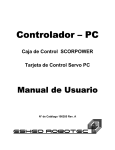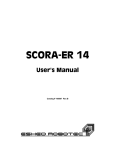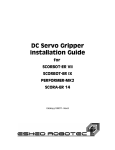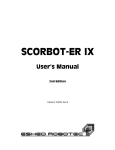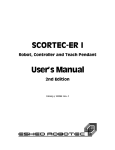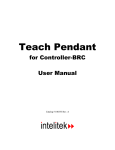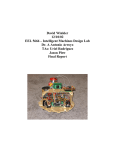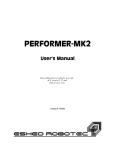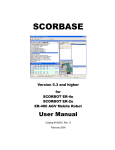Download Teach Pendant for Co..
Transcript
6'#%*" 2'0 HQT"%QPVTQNNGT/$ 7UGTIU"/CPWCN Catalog #100087 Rev. B Copyright ©1999 Eshed Robotec Catalog #100087 Rev.B (June 1995) May 1999 Reprinted/PDF version Every effort has been made to make this book as complete and accurate as possible. However, no warranty of suitability, purpose, or fitness is made or implied. Eshed Robotec is not liable or responsible to any person or entity for loss or damage in connection with or stemming from the use of the software, hardware and/or the information contained in this publication. Eshed Robotec bears no responsibility for errors which may appear in this publication and retains the right to make changes to the software, hardware and manual without prior notice. ESHED ROBOTEC INC. 444 East Industrial Park Drive Manchester, NH 03109 USA Tel: 1-800-777-6268 Tel: (603) 625-8600 Fax: (603) 625-2137 Table of Contents Introduction . . . . . . . . . . . . . . . . . . . Read This First ! Installing the Teach Pendant Operation . . . . . . . . . . . . . . . . . . . . Mounted TP . . . . . . . . . . . . . . . . Hand-Held TP . . . . . . . . . . . . . . . Auto/Teach Switch . . . . . . . . . . . . . Mounted TP . . . . . . . . . . . . . . Hand-Held TP . . . . . . . . . . . . . TP Transition . . . . . . . . . . . . . Manual Keyboard Control . . . . . . . Deadman Button . . . . . . . . . . . . . . Emergency Button . . . . . . . . . . . . . Keypad Functions . . . . . . . . . . . . . . . Display Panel . . . . . . . . . . . . . . . . . Messages . . . . . . . . . . . . . . . . . Commands . . . . . . . . . . . . . . . . Status Report . . . . . . . . . . . . . . . TP Messages . . . . . . . . . . . . . . . . . User’s Manual 9506 . . . . . . . . . . . . . . . . . . . . . . . . . . . . . . . . . . . . . . . . . . . . . . . . . . . . . . . . . . . . . . . . . . . . . . . . . . . . . . . . . . . . . . . . . . . . . . . . . . . . . . . . . . . . . . . . . . . . . . . . . . . . . . . . . . . . . . . . . . . . . . . . . 4 . 4 . 5 . 5 . 5 . 5 . 5 . 6 . 6 . 7 . 7 . 7 . 8 14 14 14 14 16 Appendix A: Installation of Teach Pendant and Controller-B EPROM Upgrading Kit . . . . . . . . . . . 1 Backup Controller Parameters and Configuration . 2 Installation . . . . . . . . . . . . . . . . . . . . . Install the Teach Pendant Mounting Fixture . . . Configure the Communication Card Jumper . . Replace the EPROMs . . . . . . . . . . . . . . Connect the Teach Pendant (and Adapter Plug) Teach Pendant Not Connected . . . . . . . . . 3 Software Installation . . . . . . . . . . . . . . . . Install ATS 1.85 and Load Parameters . . . . . . . . . . . . . . . . . . . . . . . . . . . . . . . . . . . . . . . . . . . . . . . . . . . . . . . . . . . . . . . . . . . . . . . . . . . 21 22 24 24 24 25 26 26 27 27 -5- . . . . . . . . . . . . . . . . . . . . . . . . . . . . . . . . . . . . . . . . . . . . . . . . . . . . . . . . . . . . . . . . . . . . . . . . Teach Pendant for Controller-B Introduction A new teach pendant (Catalog #1704) has been developed for use with Controller-B. This teach pendant is a sophisticated portable terminal for operating and controlling the axes connected to Controller-B. This teach pendant is equipped with an EMERGENCY STOP push-button, an AUTO/TEACH selector switch, and a DEADMAN switch. The teach pendant can be either hand-held (thus disabling its ability to run programs) or mounted in a special fixture outside the robot’s working envelope (thus enabling access to running programs). This teach pendant can be used only with a controller which is equipped with ACL version 2.28 or later and communicating with the PC by means of ATS version 1.85 or later. This teach pendant also requires that the controller and PC communicate by means of ATS version 1.85 or later. The information in this User’s Manual supplements or replaces the information given in the user’s manuals for SCORBOT-ER IX, SCORA-ER 14 and PERFORMER-MK2. User’s Manual 9506 -7- Teach Pendant for Controller-B Read This First ! Installing the Teach Pendant N If you purchased and received the teach pendant together with the Controller-B, follow the installation instructions for the teach pendant in the Controller-B User’s Manual. N If the teach pendant was purchased separately, it was supplied with the “ EPROM Upgrade Kit.” To install, you must follow the installation/ upgrade instructions in the appendix at the end of this manual. Operation N Make sure the teach pendant (or Emergency By-Pass Plug) is properly connected to the controller before you power on the system. The teach pendant can be either hand-held or mounted in a special fixture. The operation of the teach pendant will vary according to the manner in which it is held. The Auto/Teach switch on the teach pendant also affects the operation of the teach pendant, as indicated throughout this chapter. The Deadman button and the Emergency button ensure the safety of the operator. Mounted TP When the teach pendant is mounted in its special fixture, two magnetic switches are activated by means of magnetic strips on the fixture, thereby allowing programs to be run from the mounted TP. Mounting the TP ensures that the operator is safely out of the robot’s working envelope when program execution begins. The Auto/Teach switch must be in the Teach position to enable the mounted TP full control of the axes. Hand-Held TP When the teach pendant is hand-held, the deadman button must remain depressed at all times for TP operation. Programs cannot be executed from a hand-held TP. These restrictions are for safety reasons. The Auto/Teach switch must be in the Teach position to enable the hand-held TP full control of the axes. In addition, the deadman button must remain depressed; if this button is released, the system goes into the Emergency state. Teach Pendant for Controller-B -8- User’s Manual 9506 Auto/Teach Switch Mounted TP When the TP is mounted, the Auto/Teach switch affects control functions and system operation in the following ways: • • When the switch is in the Teach position, the TP has full control of the axes, and programs can be run from the mounted TP. Commands which can cause axis movement (such as CON, MOVE, RUN) cannot be entered from the keyboard. All other ACL commands (such as COFF, DIR, STAT, and EDIT) remain available when the TP is in the Teach mode. When the switch is in the Auto position, the TP is disabled, and the keyboard has full control of the axes. • When the switch is moved from Auto to Teach, running programs continue execution. Control is transferred to the TP. • When the switch is moved from Teach to Auto, running programs continue execution. Control is transfered to the keyboard, but only after the ACL command AUTO is entered from the keyboard. Hand-Held TP When the TP is hand-held, the Auto/Teach switch affects control functions and system operation in the following ways: • When the switch is in the Teach position, the TP has full control of the axes, provided the deadman button is depressed. However, programs cannot be run from the hand-held TP. Commands which can cause axis movement (such as CON, MOVE, RUN) cannot be entered from the keyboard. All other ACL commands (such as COFF, DIR, STAT, and EDIT) remain available when the TP is in the Teach mode. • When the switch is in the Auto position, the TP is disabled, and the keyboard has full control of the axes. • When the switch is moved from Auto to Teach, all running programs are aborted. • When the switch is moved from Teach to Auto, control is transfered to the keyboard, but only after the ACL command AUTO is entered from the keyboard. TP Transition If the TP is put into or removed from the mount while the switch is in the Auto position, system operation is not affected. If the TP is removed from the mount while the switch is in the Teach position, running programs are aborted. If the deadman button is released, or not properly depressed, during the removal of the TP from the mount, the system will go into the Emergency state. User’s Manual 9506 -9- Teach Pendant for Controller-B If the TP is put into the mount while the switch is in the Teach position, system operation is not affected. Once the TP is in the mount, programs can be run from the TP. Manual Keyboard Control The <Alt>+M or ~ command for switching to Manual Keyboard control is available only when the TP is in the Auto mode. If the Auto/Teach switch is moved to the Teach position when Manual Keyboard mode is active, operation from the keyboard is aborted. If the switch is then moved back to the Auto position, and the command AUTO is entered in order to return control to the PC, the keyboard is reset to DIRECT mode, but not Manual mode. The Manual Keyboard commands C (CON), F (COFF) and S (SPEED), used in previous versions of ACL, are not available in ACL version 2.28. Deadman Button The deadman button is an elongated switch on the left side of the TP, as shown in the diagram here. When the hand-held TP is in the Teach mode, this button must remain depressed at all times to enable control the axes from the TP. If the deadman button is released when the hand-held TP is in the Teach mode, the system goes into the Emergency state. Emergency Button The emergency button is the red mushroom button on the face of the TP, and functions the same as the emergency button on the controller. The emergency button can be activated regardless of the TP’s location (mounted or hand-held) or status (Teach or Auto mode). Press the button to activate; pull it out to release. When the button is pressed, the system goes into the Emergency state. To cancel the Emergency state from the TP, release the emergency botton (if it has been pressed), and press the CONTROL ON/OFF key. Teach Pendant for Controller-B -10- User’s Manual 9506 Keypad Functions The various functions of the teach pendant are described in this section. Many of the command keys on the teach pendant are ACL commands; these commands are described fully in the ACL Reference Guide for Controller-B. The teach pendant’s keypad has 25 color-coded keys. Most of the keys are multi-functional; for example, some keys include both an axis drive command and a numeric function. The controller recognizes the keys from the order in which they are pressed. Thus, the numeric function will be active only if a function such as SPEED, RUN, or MOVE has been keyed in first; otherwise, the axis drive command will be active. TP commands can be executed only when the TP is in the Teach mode and either the deadman button is depressed or the TP is mounted. The program execution command RUN is available only when the TP is mounted. Following are descriptions of the teach pendant’s keys and instructions for activating them. Bulleted items indicate the different functions of multi-functional keys. ENTER / EXECUTE • • Accepts and/or executes the command which has been entered. Starts execution of a program. JOINTS / XYZ / TOOL • Switches the command mode between Joints and Cartesian (XYZ). (TOOL is currently not available). User’s Manual 9506 -11- Teach Pendant for Controller-B CLR / GROUP SELECT • • Clears a partially entered command. Note that this is not the same as the ACL command CLR. Enables TP control of a specific axis group. Successively press for group A, group G(gripper), group B, group C, and again for group A, and so on. When group C is displayed, enter the axis number on the numerical keys. Then press Enter. Note that the TP treats the gripper as a distinct axis control group, group G. When alternating among control groups, group A will remain in the coordinate system (Joint or XYZ) in which it was last active. + • • In Joint mode, moves the selected axis in positive direction. In XYZ mode, moves the tip of the gripper in positive direction. If group G is selected, opens the gripper. In all of the above, movement will continue as long as the + key is depressed, or until the axis limit is reached. • This key is also used to confirm the DELETE command. • In Joint mode, moves the selected axis in negative direction. In XYZ mode, moves the tip of the gripper in negative direction. If group G is selected, closes the gripper. In all of the above, movement will continue as long as the – key is depressed, or until the axis limit is reached. • – • • 0 / SELECT AXIS • • Numerical key 0. Selects axis 1 through 12. Press Select Axis. Then press an axis number. Then press Enter. When an axis number is selected from the TP, the control group to which the axis belongs (A, B, C, or G[gripper]) is automatically enabled. 1 / AXIS 1 / X • • • Numerical key 1. Axis 1 in Joint mode. Axis X in XYZ mode. Teach Pendant for Controller-B -12- User’s Manual 9506 2 / AXIS 2 / Y • Numerical key 2. • Axis 2 in Joint mode. • Axis Y in XYZ mode. 3 / AXIS 3 / Z • Numerical key 3. • Axis 3 in Joint mode. • Axis Z in XYZ mode. 4 / AXIS 4 • Numerical key 4. • Axis 4 in Joint mode. • Pitch Axis in XYZ mode (MK2 and ER IX only); Roll Axis in XYZ mode (ER 14 only). 5 / AXIS 5 • • • Numerical key 5. Axis 5 in Joint mode. Gripper axis (ER 14 only) Roll Axis in XYZ mode (MK2 and ER IX only). 6 / AXIS 6 • Numerical key 6. • Axis 6 in Joint mode. Gripper axis (MK2 and ER IX only) 7 / AXIS 7 • Numerical key 7. • Axis 7 in Joint mode. 8 / AXIS 8 • Numerical key 8. • Axis 8 in Joint mode. 9 / AXIS 9 • Numerical key 9. • Axis 9 in Joint mode. User’s Manual 9506 -13- Teach Pendant for Controller-B CONTROL ON/OFF Enables and disables control of the selected group, or all groups. • If pressed once, toggles between CON and COFF for the selected group. • If pressed twice, changes CON and COFF for all axis control groups. If at least one group is in CON mode, COFF is applied to all groups. If all groups are in COFF mode, CON is applied to all groups. The action to be performed (e.g., COFF GROUP B, CON ALL GROUPS) will be displayed. Press Enter to accept. Note that selecting an axis from the TP (axis number keys) automatically enables control of the group to which the axis belongs. If the gripper axis is selected, GRIPPER is displayed and the CON/COFF toggle applies to the gripper only. RECORD POSITION This command both defines and records a position. Only numerical position names, of up to five digits, can be entered from the TP. The position is defined for the currently active group, and receives the current values of the axes in that group. The position coordinates are recorded in the currently active coordinate system. Press Record Position. Then press up to five digits for the position name. Then press Enter. If you use a position name which has already been defined, the new coordinates will overwrite the existing ones. This command is also used to record positions in a vector. The vector must first be attached (ATTACH) to the TP. INSERT / DELETE This command is used to add and remove positions in a vector. The vector must first be attached (ATTACH) to the TP. INSERT records a position in a vector, and shifts all previously recorded positions one place up in the vector. DELETE removes a position from a vector, and shifts all higher positions one place down. INSERT and DELETE are available only on position vectors which have been defined with the prefix &. • If pressed once, INSERT is displayed. Use the numerical keys to enter the number of the position (the vector index) to be inserted. Press Enter to execute the command. • If pressed twice, DELETE is displayed. Use the numerical keys to enter the number of the position (the vector index) to be deleted. Press Enter. The display shows “ ARE YOU SURE?” Press + for yes, and then press Enter again. Teach Pendant for Controller-B -14- User’s Manual 9506 SPEED(%) / SPEEDL (%) Sets the speed of manual axis movement, as a percentage of maximum speed. • If in Joint mode, sets the percentage of maximum joint speed. SPEED is displayed. • • If in XYZ mode, sets the percentage of maximum linear speed. SPEEDL is displayed. Press SPEED(%)/SPEEDL(%). The current speed is displayed. Press Enter to accept the displayed default speed. Or use the numerical keys to enter a different speed, and press Enter. When group G is active, this command determines the speed of a DC servo gripper. OPEN / CLOSE Opens and closes the gripper. This command functions on both electric and pneumatic grippers. MOVE / MOVEL Moves the axes to a target position. MOVEL applies only to robot (group A) axes. • If in Joint mode, movement is by joints (MOVE) • If in XYZ mode, robot movement is linear (MOVEL) Press MOVE/MOVEL. Then use the numerical keys to enter the position number. Press and hold the Execute key. Continue holding down the Execute key until the axes reach the target position. If the Execute key is released, the movement is stopped immediately, and the command is aborted. • The command MOVE 0 moves the axes of the currently active group (A or B only) to their home position. The TP display panel will show MOVE 0 for group A, and MOVE 00 for group B. • When group G is active, pressing this key activates the JAW command for the gripper. Use the numerical keys to enter a value for the percentage of the gripper opening, and press Enter. SPLINE / MOVEC Moves the axes to a target position. MOVEC applies only to robot (group A) axes. SPLINE applies only to multi-axis devices in group A or group B axes. • If pressed once, a SPLINE movement will be executed. • If pressed twice, a MOVEC movement will be executed. Use the numerical keys to enter the first position number, and press Enter. Use the numerical keys to enter the second position number. Then press and hold Execute. User’s Manual 9506 -15- Teach Pendant for Controller-B Continue pressing the Execute key until the axes reach the target position. If the Execute key is released, the movement is stopped immediately, and the command is aborted. RUN Executes a program. Available only when the TP is mounted. Press Run. Then press the program’s identity number on the numerical keys. The program name will be displayed in brackets. Then press Enter. The controller automatically assigns an ID number to each user program. The ACL command DIR lists the programs and their assigned (IDENTITY) number. • • The command RUN 0 homes the robot axes (ACL command HOME). The command RUN 999 executes a system test (ACL command TEST). SINGLE STEP This command is not currently available. ABORT Aborts execution of all running programs. Stops the robot and all peripheral axes. Display Panel The teach pendant has a four-line liquid crystal display panel. Each line displays a specific type of message or text. Messages When the TP is in either the Teach Mode or Auto mode, line 1 displays system and error messages. The current display is erased when a new message appears. When the TP is in the Auto mode, lines 2, 3 and 4 will display: TP IN AUTO MODE TEACH MODE WILL ABORT ALL PROGRAMS A list and brief descriptions of all TP messages appears at the end of this chapter. Commands When the TP is in the Teach mode, lines 2 and 3 display commands. Line 2 displays the last command entered. Subsequent commands are scrolled into Line 2. Line 3 displays the command currently being entered, and serves as a user interface. • The command SPEED/SPEEDL will display the current value, allowing you to accept or change. Teach Pendant for Controller-B -16- User’s Manual 9506 • The commands SPLINE/MOVEC, INSERT/DELETE, RECORD POSITION and MOVE/MOVEL will display the name of the currrently attached position vector, if it exists, and the active control group. Status Report When the TP is in the Teach mode, line 4 displays the current status of the axes, in the following format: group:g AX: xx cccccc When the group (or a specific group C axis) is enabled (CON), the text in the display is normal (black on white). When the group (or a specific group C axis) is disabled (COFF), the text in the display is inversed (white on black). g is the currently selected axis control group (if exists): A: control group A G: gripper B: control group B C: control group C xx is the currently active joint or axis in the active group: 1-12: joint X : X axis Y : Y axis Z : Z axis P : Pitch axis R : Roll axis cccccc is the currently active coordinate system: Joint XYZ Examples GROUP:C AX:11 JOINTS Group C, Axis 11 is active, Joint mode, in COFF state. GROUP:A AX:P XYZ Group A, Pitch axis is active, XYZ mode, in CON state. User’s Manual 9506 -17- Teach Pendant for Controller-B TP Messages The following is an alphabetical listing of the system messages which may appear on line 1 of the teach pendant during manual operation and program execution. The explanation of each message includes the system’s ID number for the message and the text of the comparable message which appears on the computer screen. Refer to the ACL Reference Guide for Controller-B for complete descriptions of these messages and full instructions for correcting situations which cause the display of an error message. ARITHMETIC OVFL (302) Arithmetic overflow (or division by zero) The result of a mathematical operation is out or range (or invalid). AXIS DISABLED (304) Axis disabled. Servo control of the arm has been disabled (COFF). BAD AXIS (310) Invalid axis. The axis is not in the group specified by the command, or the axis is not configured. BAD GROUP (321) MOVES/SPLINE not allowed for a single axis group. The command (MOVES) cannot be executed on a single axis group. BAD POINT n (312) Invalid position coordinate values. You attempted to use an invalid position. BAD XYZ POSITION (317) Invalid Cartesian position pos. The position could not be recorded or reached because its XYZ coordinates are out of the XYZ envelope. Teach Pendant for Controller-B -18- User’s Manual 9506 CONTROL DISABLED (72) CONTROL DISABLED. Motors have been disconnected from servo control. CONTROL ENABLED (73) CONTROL ENABLED. Motors are now under servo control. EMERGENCY (148) To perform action - release emergency button. The emergency switch has been pressed. HOME FAIL (51) *** HOME FAILURE AXIS n. The homing procedure failed for the specified axis. HOME NOT DONE (301) Group/axis has not been homed. You attempted to move the arm to a recorded positions, or to record a position, before homing was performed on the group or axis. HOMING (31) WAIT !! homing... Homing complete (32) Homing complete IMPACT axis n (53) *** IMPACT PROTECTION axis n The controller has detected a position error which is too large. The system aborted all movements of that axis group, and disabled all axes of that group. INCOMPATIBLE PNT (315) Incompatible positions. The position or positions you attempted to manipulate are dedicated to different axis control groups. User’s Manual 9506 -19- Teach Pendant for Controller-B Index or data error (36) Invalid index or value. The command has an incorrect index value. INDEX RANGE (309) Index value - out of range. The value of the index is out of range. INVALID PROGRAM (306) Invalid program. Faulty syntax or logic in the program. LIMIT AXIS n (33) *** UPPER LIMIT AXIS n (34) *** LOWER LIMIT AXIS n Axis encoder has reached either its maximum or minimum allowed value. MOTORS OFF (201) (319) Motor power switch is off. The motor power supply is switched off. NO GRIPPER (316) No gripper configuration. The command cannot be executed because a gripper has not been configured. No free space (159) No free space to insert point All positions in the vector have been allocated; no memory available. No hard homing (40) Cannot hard home axis n. The specified axis has not been configured for hard homing. NO POSITION (303) No coordinate values for position n. The position coordinates have not been recorded or set. Teach Pendant for Controller-B -20- User’s Manual 9506 NOT ABS POINT (322) Position must have Absolute Joint coordinates. The command (MOVES) can only be executed on positions with absolute JOINT values. NOT XYZ SPACE (320) Robot is not in XYZ space. The robot is at a position at which the XYZ coordinate system is not supported. POINT LOOP (311) Relative chain loops or exceeds 32 positions. An error in the linking or recording of the positions in a chain of relative positions. Point not assigned (74) No coordinate values for position. The position coordinates have not been recorded or set. POINT NOT FOUND (110) Position not found. The position you attempted to use cannot be reached. POINT TYPE n (313) Incompatible position type pos. You have attempted to use a position whose type is incompatible with the command. Pnt not def or array (145) Position is not defined or is not a vector. The position has not been defined, or this is not the name of a position vector. PROGRAMS ABORTED (205) All programs aborted. The TP Abort key has been pressed or the mounted TP has been removed from the fixture when in the Teach mode. User’s Manual 9506 -21- Teach Pendant for Controller-B RANGE axis n (54) *** OUT OF RANGE axis n. An attempt was made to record a position (HERE, HEREC, etc. ) while the robot arm was out of its working envelope. THERMIC axis n (55) *** THERMIC OVERLOAD axis n. The system has detected a dangerous condition for that motor. The system aborted all movements of that axis group, and disabled all axes of that group. TOO DEEP NESTING (305) Nesting too deep. Too many GOSUB subroutines are nested within one another. TOO FAST axis n. (99) *** SPEED TOO FAST axis n. The controller has detected a movement which is too fast. use HERE or HEREC (160) INSERT position is empty, use HERE or HEREC You attempted to insert a position which does not have any coordinate values. Teach Pendant for Controller-B -22- User’s Manual 9506 Appendix A Installation of Teach Pendant and Controller-B EPROM Upgrading Kit N If you purchased and received the teach pendant together with the Controller-B, follow the installation instructions for the teach pendant in the Controller-B User’s Manual. N If the teach pendant was purchased separately, it was supplied with the “ EPROM Upgrade Kit.” This kit contains the following items: • Set of four ACL EPROMs, version 2.28 or later • ATS software diskette, version 1.85 or later • Documentation ATS for Controller-B Reference Guide Teach Pendant for Controller-B User’s Manual To install, follow the installation/ upgrade instructions in this appendix. You must perform, in sequence, all of the procedures. User’s Manual 9506 -23- Teach Pendant for Controller-B 1 Backup Controller Parameters and Configuration 1. Turn on the computer and the controller. Activate ATS using your existing software. (Do not yet use ATS 1.85.) Activate the ATS Backup Manager menu. Perform two backup operations, making sure you use two different file names. • Select the options “ Backup ALL” and “ BACKUP to disk (F3).” to backup the entire contents of the controller to the ATS directory. Use the file name ALLBU, for example. • Select the options “ Backup PROGRAMS” and “ BACKUP to disk (F3).” to backup the programs, positions and variables in the controller to the ATS directory. Use the file name PROGBU, for example. 2. At the end of the manufacturing process, each robot undergoes an individual calibration procedure. The results of this procedure are assigned to a set of parameters which belong specifically to each robot. These parameters are included in a file named PARn.CBU in the ATS software diskette which was originally supplied with the robot. n indicates the type of robot; that is: • PAR9.CBU contains the parameters for SCORBOT-ER IX • PAR14.CBU contains the parameters for SCORA-ER 14 • PARMK2.CBU contains the parameters for PERFORMER-MK2 The ATS 1.85 diskette includes PARn.CBU files. But they are not competely suitable for use. To ensure the best peformance of your robot, you will need to transfer the calibration parameter values from the old CBU file to the new CBU file. From the ATS main screen, use the ACL command SHOW PAR to display the values of the following parameters. Write down the values displayed. Teach Pendant for Controller-B -24- User’s Manual 9506 The command format is as follows: SHOW SHOW SHOW SHOW SHOW PAR PAR PAR PAR PAR 101 102 103 104 105 not required for SCORA-ER 14 SHOW SHOW SHOW SHOW SHOW PAR PAR PAR PAR PAR 121 122 123 124 125 not required for SCORA-ER 14 SHOW SHOW SHOW SHOW SHOW PAR PAR PAR PAR PAR 1 2 3 4 5 not required for SCORA-ER 14 SHOW PAR 301 SHOW PAR 302 SHOW PAR 308 SHOW PAR 309 SHOW PAR 310 for TOOL command for TOOL command for TOOL command Be sure you have an exact record of the values. Refer to the ACL for Controller-B Reference Guide for complete descriptions of these parameters. 3. From the ATS main screen, enter the ACL command: CONFIG ? The controller’s configuration will be displayed on your computer screen. Make a hard copy of the configuration. 4. Exit to DOS. Turn of the computer. Turn off the controller. You may now proceed to the hardware procedures. User’s Manual 9506 -25- Teach Pendant for Controller-B 2 Hardware Installation Install the Teach Pendant Mounting Fixture This special fixture is required for reasons of safety. N Install this fixture safely outside the working range of the robot and peripheral axes. The fixture has two magnetic strips which activate two magnetic switches on the teach pendant. When the teach pendant is mounted in this fixture, programs can be executed from the teach pendant; when the teach pendant is hand-held, program execution cannot be activated from the teach pendant. The fixture for mounting the teach pendant is supplied with a set of screws for mounting. Configure the Communication Card Jumper Jumper JP3 on the controller’s communication card, shown in the diagram below, must be open when the controller’s ACL version is 2.28 or later; otherwise the teach pendant’s Emergency button will not function. N Be sure the controller is switched off. 1. Unscrew the Phillips screws which hold the cover of the controller. Lift off the cover and set it aside. 2. Locate the communication card (PC17600) behind the power supply. Remove the connector at J4 at the top of the communication card (1). This will permit you access to jumper JP3 (2). 3. Remove jumper JP3. 4. Reconnect the connector at J4. Communication Card PC17600 Teach Pendant for Controller-B -26- User’s Manual 9506 Replace the EPROMs ACL is programmed onto a set of four EPROMs which are mounted on the controller’s CPU board, indicated by (3) in the diagram below. CPU Board PC17050 1. The battery must be removed before the EPROMs can be replaced. The round backup battery is mounted in a plastic housing at the top of the CPU card, indicated by (5) in the diagram above. Using a small screwdriver, pry the battery loose. Pull out the battery, and set it aside. Note that removing the battery from the CPU board erases the controller’s battery-backed RAM. 2. Unscrew the screws which hold the CPU board inside the controller. Carefully lift out the CPU board. 3. Locate the four EPROMs mounted in U11, U12, U13 and U14 on the CPU board. Using an IC extracting tool, carefully remove these four EPROMs. 4. Carefully insert the four new EPROMs into the empty sockets of U11, U12, U13 and U14. Insert each EPROM by aligning the notch and the pins on the chip with the notch and the pin receptacles on th e socket. Gently push the chip into the socket until it is firmly seated, as shown in the diagram at right. User’s Manual 9506 -27- Teach Pendant for Controller-B 5. Carefully replace the CPU board into its slot on the main board. Make sure the connector pins and receptacles are aligned, then firmly but gently press the board into its slot. 6. Refasten the screws holding the CPU board to the main board. 7. Replace the battery. Slide it into the slot until it snaps into place. 8. Replace the controller cover, and refasten the screws. 9. Reconnect the power cables. Connect the Teach Pendant (and Adapter Plug) If you do not intend to connect the teach pendant, skip this section, and go to the following section, “Teach Pendant Not Connected.” N Be sure the controller is switched off before you connect the teach pendant. The teach pendant is supplied together with a D25 adapter plug. This adapter enables communication between the teach pendant and the controller; it converts teach pendant serial data to parallel, and controller parallel data to serial. 1. Connect this adapter plug to the port marked Teach Pendant on the controller’s rear panel, as indicated by the arrow in the diagram below. 2. Tighten the retaining screws. 3. Connect the connector on the teach pendant cable to the adapter plug. Controller Rear Panel (Partial View) Teach Pendant Not Connected N When the Controller-B teach pendant is not connected to the controller (version 2.28 and later), the Emergency By-Pass Plug must be connected instead. This plug prevents the controller from activating EMERGENCY status when the teach pendant is absent. 1. Connect the by-pass plug to the controller’s Teach Pendant port. 2. Tighten the retaining screws. Teach Pendant for Controller-B -28- User’s Manual 9506 3 Software Installation Install ATS 1.85 and Load Parameters N Make sure the teach pendant (or Emergency By-Pass Plug) is properly connected to the controller before you power on the system. 1. Turn on the computer and the controller. 2. Before proceeding with the upgrade procedure, rename your current ATS directory; ATS_OLD, for example. 3. Install the ATS 1.85 software in a new ATS directory. (Copy all the files from the ATS 1.85 diskette to the directory.) 4. Activate ATS. 5. Configure the controller. Do either one of the following: • Press [Ctrl]+F1 for automatic controller configuration. • Use the ACL command CONFIG. When prompted, enter the values which were displayed when you entered the command CONFIG ? previously. 6. You will now update the parameters for your system with the values which you recorded earlier. This is a critical step, which you must perform exactly, as it will affect the performance of your robot. Use the ACL command LET PAR, to reset the parameter values. If you encounter a message for PRIVILEGE mode, you will have to enable the password-protected PRIVILEGE mode. (Refer to the ACL Reference Guide for Controller-B for instructions). The command format is as follows (where val is the value displayed by the SHOW PAR command which you used previously. LET PAR 101=val LET PAR 102=val LET PAR 103=val LET PAR 104=val LET PAR 105=val not required for ER 14 LET PAR 121=val LET PAR 122=val LET PAR 123=val LET PAR 124=val LET PAR 125=val not required for ER 14 LET PAR 1=val LET PAR 2=val LET PAR 3=val User’s Manual 9506 -29- Teach Pendant for Controller-B LET PAR 4=val LET PAR 5=val not required for ER 14 LET PAR 301=val LET PAR 302=val LET PAR 308=val LET PAR 309=val LET PAR 310=val 7. Use the ACL command INIT CONTROL to reinitialize the controller with the new parameter values. 8. You will now record this parameters in the new PARn.CBU. Use the ATS Backup Manager and the option “ Backup PARAMETERS” to save the parameters fromthe controller to the file PARn.CBU. Make sure the Backup directory is the new ATS directory. 9. If you want to reload the programs and positions you backed up earlier, use the ATS Backup Manager and the option “ Restore PROGRAMS” to restore the file PROGBU. Note that this file will be found in the Backup directory ATS_OLD. 10. If you have restored programs, carefully check a restored application to see that it runs properly. This completes the installation/upgrade procedure. You may now use the Teach Pendant. Teach Pendant for Controller-B -30- User’s Manual 9506

































